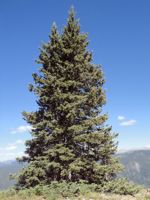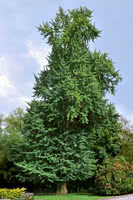Mon-Fri 9am - 5pm Mountain time
Douglas Fir vs Ginkgo Biloba
Pseudotsuga menziesii var. glauca
Ginkgo biloba
NOT AVAILABLE THIS SEASON - MIGHT RETURN
Douglas Fir is a large coniferous tree with a pyramidal shaped crown.
This attractive feature tree, with its distinctive drooping cones, is perfect for any grower who has lots of space and lives in a warm enough region. Douglas Firs make exceptional Christmas trees.
It is not suitable to all growing environments. Do some research and make sure this tree is right for you.
Our seed source is typically from the interior of BC and rocky mountain areas. We do not produce coastal seed source Douglas Fir as it is better suited to its native range and some taxonomists believe the two seed sources might be distinct.
The Ginkgo Biloba is regarded as one of the most distinctive and beautiful of all the deciduous trees, and has remained genetically unchanged for millions of years. Its beautifully fan-shaped leaves develop a clear yellow colour in fall. Graceful and attractive year-round, Ginkgo is the perfect conversation starter in your yard.
Douglas Fir Quick Facts
Ginkgo Biloba Quick Facts
Toxicity: Uncooked nuts in large quantities

